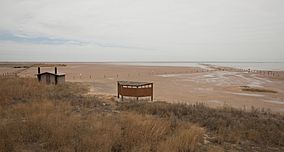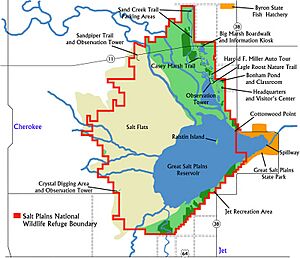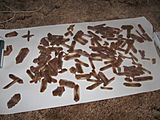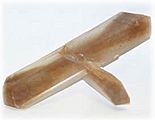Salt Plains National Wildlife Refuge facts for kids
Quick facts for kids Salt Plains National Wildlife Refuge |
|
|---|---|
|
IUCN Category IV (Habitat/Species Management Area)
|
|

Crystal digging area of the Salt Plains
|
|
| Location | Alfalfa County, Oklahoma |
| Nearest city | Jet |
| Area | 32,080 acres (129.8 km2) |
| Established | 1930 |
| Governing body | United States Fish and Wildlife Service |
| Website | Salt Plains National Wildlife Refuge |
| Designated: | June 1983 |
The Salt Plains National Wildlife Refuge is a special protected area in the United States. It's located in Alfalfa County in northern Oklahoma. You can find it north of a small town called Jet. The refuge is right next to Great Salt Plains Lake. This lake was formed by a dam on the Salt Fork of the Arkansas River.
This refuge was created on March 26, 1930, by President Herbert Hoover. It protects about 32,080 acres (130 km2) of land. This land is home to around 312 different kinds of birds and 30 types of mammals. In June 1983, it was named a national natural landmark. This means it's a very important natural place.
Contents
Exploring the Salt Plains Refuge
The Salt Plains used to be a favorite hunting spot for American Indians. Animals like Bison came here to eat the salt. The area near the Salt Fork River had lots of trees and water. It was like a green oasis in the wide, open Great Plains.
The refuge is split into three main parts. There are large, flat areas of non-vegetated salt flats. There's also open water and land covered with plants. You'll find Marshes, woods, grasslands, and even some croplands here. To help the wildlife, people manage the land. They use farming, grazing, and controlled fires. They also build ponds and manage wetlands.
Wildlife and Bird Habitats
The main reason the refuge was created was to be a safe place for migratory waterfowl. These are birds that travel long distances. They use the refuge to rest and breed, especially in spring and fall.
The entire refuge is a very important home for the endangered whooping crane. You can often see these rare birds during their fall migration. Other special birds here include endangered least terns and threatened snowy plovers. You might also spot threatened bald eagles and peregrine falcons. Huge groups of American white pelicans fly through here. They stay on the Great Salt Plains Reservoir from August to September. The Great Salt Plains is one of the most important places for shorebirds in the Western Hemisphere.
Ralstin Island: A Bird Nursery
Ralstin Island is a special place within the Great Salt Plains Lake. It's closed to the public to protect the birds. This island is an important rookery, which is a place where many birds gather to breed. The island used to be 25 acres (100,000 m2), but it has gotten smaller over time. Now it's about 6 acres (20,000 m2).
More than 30,000 birds use this island during breeding season. Over 30 different kinds of birds build their nests here. These include the white-faced ibis, great blue herons, and especially the tricolored heron.
Historical Discoveries at the Plains
In 2007, a Boy Scout was digging for crystals. He found some old vials from World War II. These vials contained chemicals that were part of military identification kits. Back then, burying these vials was a common way to get rid of them. No one knew there was a burial site at the Salt Plains.
Crystal digging was stopped for two years while experts checked the area. They removed 171 vials and other old military items. The salt plains were also used for military training during World War II. You can still find some signs of this history today.
Fun Activities at the Refuge
There are many ways to enjoy the Salt Plains National Wildlife Refuge.
Driving and Hiking Trails
The Harold F. Miller Auto Tour is a fun way to see the refuge. It's a 2.5 miles (4 km) dirt road that starts near the nature center. You'll drive past ponds and fields where food for wildlife is grown. You might see White-tailed deer and other animals. A short 0.25 miles (400 m) trail leads to Casey Marsh Tower. From there, you can watch many waterfowl and even bald eagles in fall and winter.
There are also great hiking trails. The Sandpiper Trail is 0.35 miles (600 m) long. It starts near the nature center and leads to the salt flats. There's a platform for bird watching there. The Eagle Roost Nature Trail is a 1.25-mile (2.0 km) loop. It also begins near the nature center. This trail goes through woods and open areas. You'll walk under tall cottonwood trees and past marshes and ponds. It also leads to a spot on Sand Creek Bay where you can watch shorebirds and waterfowl.
Digging for Selenite Crystals
A special part of the 11,000 acres (45 km2) salt flats is famous for its crystals. Here, you can find selenite crystals. Selenite is a crystalline form of gypsum. The selenite crystals found here are unique. They have an hourglass shape made of sand inside them. This hourglass shape isn't found in selenite crystals anywhere else in the world!
You are allowed to dig for these crystals. However, you can only dig from April 1 to October 15. This rule helps protect the important habitat for the Whooping Crane.
Hunting and Fishing Opportunities
About 1,250 acres (5 km2) of the refuge is open for hunting. This area is north of Highway 11. State hunting laws apply here. However, if you want to hunt deer, you need a special permit. You can hunt for pheasant, northern bobwhite quail, mourning dove, ducks, geese, and sandhill cranes.
Fishing is also allowed in some parts of the refuge. You can fish from April 1 to October 15 in most areas. Some areas are closed, and these are marked with buoys or signs. Bonham Pond is a special fishing spot. Only children under 14 and people with mobility challenges can fish there. It's also catch-and-release only. Great Salt Plains Lake is known for its large channel and other catfish. Other fish you might catch include striped bass, largemouth bass, crappie, white bass, panfish, and walleye. Remember to follow state laws for how many fish you can catch. Also, you can't use boats in the river and creeks.
Images for kids






